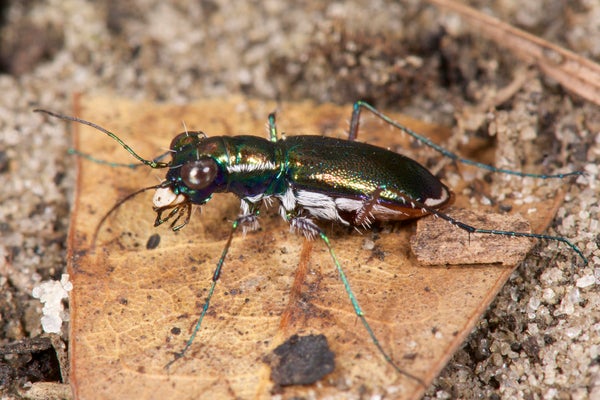This article was published in Scientific American’s former blog network and reflects the views of the author, not necessarily those of Scientific American
A rare beetle from Florida was granted protections under the Endangered Species Act last week just in the nick of time. Without the ESA, the last two habitats of the Miami tiger beetle (Cicindela floridana) might have disappeared to make way for a Walmart and a theme park.
Unfortunately, the news isn’t as good for two other beetle species from Arizona and Kentucky. Both the Tatum Cave beetle (Pseudanophthalmus parvus) and the Stephan's Riffle beetle (Heterelmis stephani), which were also candidates for Endangered Species Act protection, have instead been declared extinct.
This is actually a pretty good turn of events for the Miami tiger beetle—an aggressive predator from the unique pine rocklands ecosystem of South Florida—which was first documented by science back in 1934 but then went unseen for another six decades. It was actually thought to be extinct until it was rediscovered in 2007 in Miami. The Center for Biological Diversity filed an emergency petition for protection in 2014 and the U.S. Fish and Wildlife Service proposed the species be listed under the ESA a year later. Last week the agency formalized those protections.
On supporting science journalism
If you're enjoying this article, consider supporting our award-winning journalism by subscribing. By purchasing a subscription you are helping to ensure the future of impactful stories about the discoveries and ideas shaping our world today.
“Only two small populations of the rare Miami tiger beetle still survive in its pine rockland habitat,” Cindy Dohner, FWS Southeast Regional Director, said in a prepared release. “We are listing the beetle to ensure its continued survival and conserve its shrinking habitat.” Although the agency did not yet declare critical habitat for the species, it has taken steps to preserve the land where the beetle lives. “We are working closely with prospective developers and key stakeholders in Miami-Dade County to ensure that the Miami tiger beetle is considered in development or management plans,” Dohner said.
Unfortunately, things did not move as quickly for the other two beetles. FWS recognized that the Stephen’s riffle beetle and the Tatum Cave beetle each probably needed protection back in 1984 and 1994, respectively, but failed to take action because other species were considered higher priorities. That now delay appears to have been enough time to push both species into extinction. FWS conducted numerous searches for the two beetle species, none of which turned up any evidence of their survival. Last week, in response to another lawsuit by the Center for Biological Diversity, the agency declared that neither beetle would be protected under the ESA because both species are now presumed to be extinct.
The Tatum Cave beetle was last seen in 1965. It probably went extinct due to a combination of pollution, human visitation of its cave habitat, drought and other factors. Stephen’s riffle beetle, meanwhile, has not been observed since 1993. One of its two known habitats was converted into a campground while the other saw its water supplies diverted for what FWS described as domestic and recreational water supplies.
“Few people ever saw the Stephan’s riffle beetle or the Tatum Cave beetle, and perhaps not many will mourn their passing,” the Center for Biological Diversity’s Michael Robinson said in a prepared release. “But the extinction of species, tiny and tremendous alike, leaves us all a little poorer, whether we recognize the losses or not.”
FWS acknowledged that both the Tatum Cave and Stephen’s riffle species, like the Miami tiger beetle, could conceivably still exist but just be hard to locate. If they ever turn up again, the agency said it will reconsider their protection. However, given the amount of time since they have been seen, the intense efforts to locate them, and the destruction caused to their tiny habitats, that seems unlikely at best.
Previously in Extinction Countdown:
